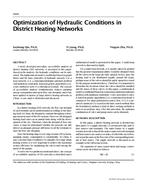Different laboratory tests and procedures (ASTM 0236, ASTM 0976, and AAMA 1503 .1) are discussed in the context of measuring U-values of direct gain fenestration (DGF) components such as windows and movable insulation for windows. Four representative DGF components, including a multiple-glazed window and three single-glazed windows with movable insulation systems, were purchased and prepared for testing . U-Values were measured for each test component at two commercial testing laboratories using the ASTM C236 and the AAMA procedures for a range of simulated outdoor conditions. Difficulties were experienced by one test lab in calibration testing of a low-conductance test frame and in testing at nonstandard conditions. When the test results from this lab were recalculated, meaningful comparison between the results from the different laboratories was possible.
Comparison of laboratory test results with the DGF manufacturer’s R-Values showed discrepancies varying between 20% and 117% . For the three movable insulations tested, the manufacturer’s claims for energy savings were also overstated, suggesting the need for a standard method for estimating energy performance.
Test results between individual laboratories are compared and differences are noted where wind speeds of 15 mph (6.7m/s) were simulated. The differences are attributed to the different directions (parallel and perpendicular) used by each laboratory for simulating wind . Measured U-values are compared with ASHRAE design data for an insulating shade and a multiple-glazed window for a range of outdoor wind speeds and ambient temperatures. Recommended practices for measuring U-values and for interpreting test results are discussed.
Units: Dual
Citation: ASHRAE Transactions, 1986, vol. 92, pt. 1A, San Francisco
Product Details
- Published:
- 1986
- Number of Pages:
- 21
- File Size:
- 1 file , 1.9 MB
- Product Code(s):
- D-SF-86-2966


